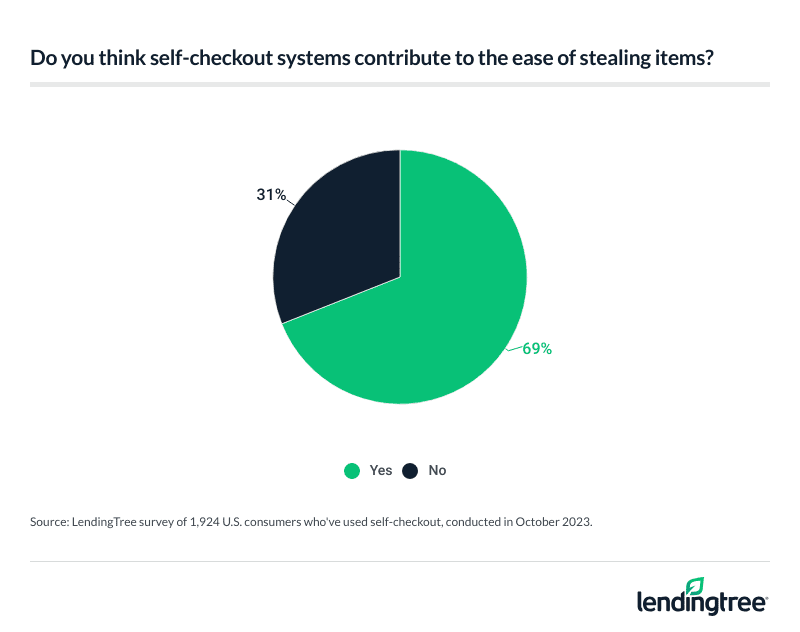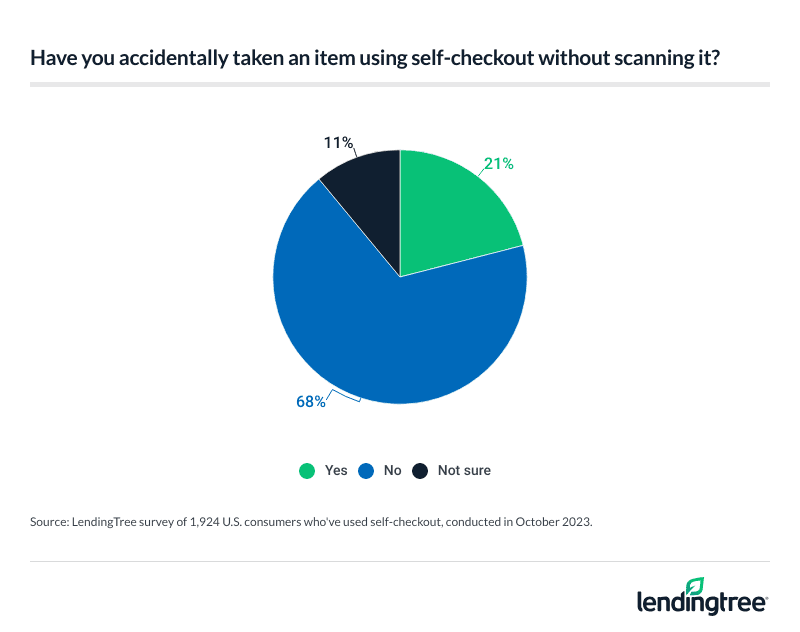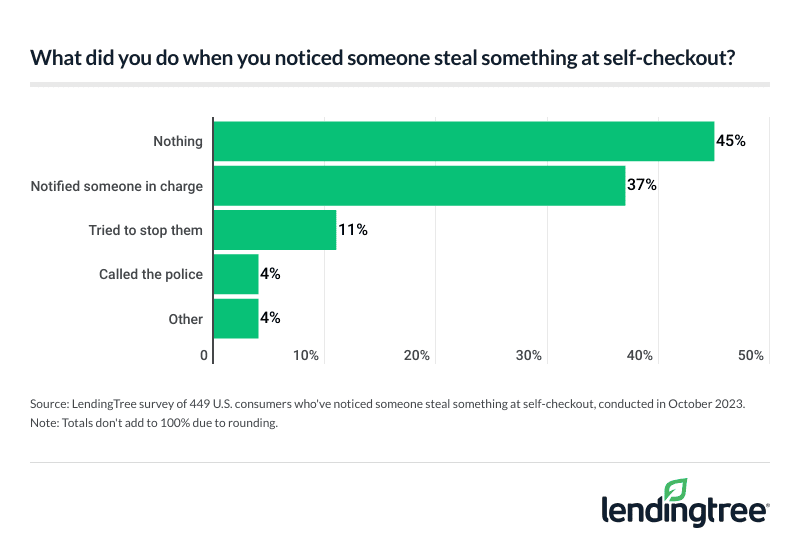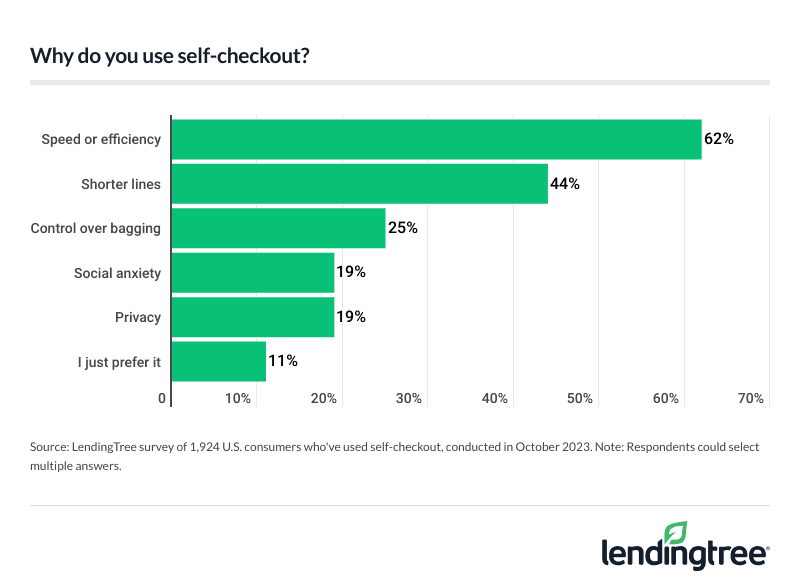69% of Self-Checkout Users Think It Makes Stealing Easier — And 15% of Shoppers Admit to Purposely Doing So
Self-checkout machines can make our lives easier at the grocery store, but some self-appointed cashiers are self-appointing discounts. According to the latest LendingTree survey of 2,000 U.S. consumers, 15% of self-checkout users have purposely stolen an item — and 44% of self-checkout thieves plan to do it again.
We’ll go over which demographics are most likely to steal at self-checkout, what they plan to take in the future and how Americans react when they see others doing it. With many thieves planning to steal essentials like food, water or health care goods in the future, stick around for tips on expanding your grocery store budget.
Key findings
- Self-checkout machines are convenient for consumers, but some are granting themselves five-finger discounts. Almost all Americans (96%) have used self-checkout at one point or another. Most Americans say they enjoy it for speed and convenience, but 69% of users believe the machines contribute to shoplifting.
- While not many Americans admit to stealing via self-checkout, those who do don’t necessarily plan to stop. 15% of self-checkout users confess to purposely stealing. While 60% of those who have stolen felt remorseful and 33% say they’ve been caught, 44% say they’ll likely do it again. Although 79% of self-checkout users diligently ensure each item scans, 21% admit to accidentally taking an item — and guilt didn’t get the better of the 61% who kept it anyway.
- With often fewer financial resources, younger generations are more likely to use the machines to steal. 31% of Gen Zers and 21% of millennials have purposely taken an item without scanning it. Overall, though, shoplifters aren’t necessarily taking big-ticket items — the self-reported value of the stolen goods is $60, on average. Among those who plan to steal in the future, 46% say they’ll target items more expensive than anything else in their cart, while 37% will help themselves to essentials like food, water or health care goods.
- Some consumers won’t step in when they see someone else stealing. While 23% of self-checkout users think they may have witnessed someone else steal from a machine, 45% say they did nothing about it. Some consumers have been hit with false accusations, as 10% of self-checkout users say they’ve been wrongfully accused of taking something. That figure rises to 17% among Gen Zers and 14% among millennials.
- Overall, opinions on self-checkout machines are mostly positive. Across Americans, 41% almost always use self-checkout if it’s an option. When asked why they like these machines, 62% say they like the efficiency, 44% like the shorter lines, 25% like having control over bagging and 19% each cite social anxiety and privacy. On the flip side, 21% of consumers say self-checkout makes them feel they’re doing free labor for the store and 14% feel like they’re taking someone’s job by using the technology.
Self-checkout machines are convenient, but they come at a cost
Self-checkout machines have become a universal presence at many stores. In fact, 96% of Americans have used self-checkout at least once. Although they’re seen as a convenient and fast option, 69% of users believe the machines contribute to shoplifting.
According to LendingTree chief credit analyst Matt Schulz, both can be true.
“While self-checkout is convenient, it certainly poses a risk for shoplifting,” he says. “Ultimately, retailers need to decide whether the self-checkout terminals are worth the risk. Sure, they can help the store save money because fewer people are needed to check out customers. The question, however, is whether that savings outweighs the potential uptick in theft. That’s a question lots of retailers are likely wrestling with.”

Among self-checkout users, baby boomers ages 59 to 77 (80%) are the most likely to believe self-checkout plays a role in shoplifting. Meanwhile, just 64% of millennials ages 27 to 42 and Gen Zers ages 18 to 26 say similarly.
By income group, six-figure users (78%) are the most likely to believe self-checkout machines contribute to shoplifting, while those earning less than $35,000 (63%) are least likely. Additionally, men (71%) are more likely to share this sentiment than women (68%).
Self-checkout thieves are likely to steal again
Those who believe self-checkout contributes to stealing may be right. In fact, 15% of users confess to purposely stealing at these machines.
Thieves can have a guilty conscience, though, and many self-checkout stealers do. Of those who have stolen, 60% say they felt remorseful. Meanwhile, 33% say they were caught. Of men who’ve stolen at self-checkout, 37% say they’ve been caught, compared with 28% of women. Additionally, those with children younger than 18 (40%) are much more likely to be caught stealing than those without children (27%).
Despite the potential consequences of stealing (emotional or otherwise), 44% of thieves say they’ll likely do it again. Men (52%) are much more likely to say so than women (33%). Those with children younger than 18 (50%) are also more likely to say they’ll steal at self-checkout in the future than those without children (39%).
Still, not all thievery is intentional. Although 79% of self-checkout users diligently check to see if their items scan, 21% say they’ve taken an item accidentally. And the majority of accidental thieves are still thieves. Of those who’ve unintentionally swiped an item, 61% kept it anyway. Meanwhile, just 29% returned it.

Younger generations most likely to steal
Who’s the most likely to swipe something at self-checkout? Younger generations lead the way, with 31% of Gen Zers and 21% of millennials admitting to purposely taking an item without scanning it.
Those with children younger than 18 (24%) are significantly more likely to have purposely stolen an item than those with no children (13%) and those with children older than 18 (8%). Meanwhile, 18% of six-figure earners say they’ve stolen at self-checkout. Comparatively, 14% of those earning less than $35,000 or $50,000 to $74,999 say similarly.
Overall, though, shoplifters aren’t taking valuable items. On average, the self-reported value of the goods stolen is $60. Notably, men report stealing goods worth $78, on average, while women report stealing goods worth an average of $35.
When it comes to those who plan to steal again, 46% say they’ll target items more expensive than anything else in their cart. Meanwhile, 37% will help themselves to essentials like food, water or health care goods.
Schulz believes high costs may affect the percentage of thieves who plan to steal essential items. “For one, things like food, water and health care items are expensive as inflation lingers,” he says. “Also, it’s possible that potential thieves might feel that they may be treated more harshly for stealing pricier goods than for taking relatively inexpensive merchandise. Walking away without paying for a candy bar or a bunch of bananas is one thing. Walking away with an air fryer or a laptop computer is something else.”
Shoppers may not step in when they notice others stealing
Consumers aren’t likely to play hero at self-checkout. Overall, 23% of self-checkout users have witnessed someone else steal from one of the machines. Of this group, 45% did nothing about it — the most common response. Notably, women (48%) are more likely to do nothing than men (42%).
Meanwhile, 37% notified someone in charge.

False accusations happen, though, and 10% of self-checkout users say they’ve been wrongfully accused of taking something. Younger consumers are particularly likely to get accused, at 17% among Gen Zers and 14% among millennials.
Those with children younger than 18 (16%) are also among the most likely to be wrongly accused. That compares with 8% of those without children and 4% of those with children older than 18.
Generally, consumers enjoy self-checkout
Despite the self-appointed discounts and occasional false accusations, consumers tend to prefer self-checkout. If it’s an option, 41% of Americans almost always use self-checkout. Meanwhile, 24% use self-checkout depending on how many items they have and 20% use it depending on how long the lines are.
When asked why they use self-checkout, 62% of users say they like the efficiency — the most common response. Meanwhile, 44% like the shorter lines, 25% like having control over bagging and 19% each cite social anxiety and privacy. The percentage of those who use self-checkout due to social anxiety is nearly twice as high among Gen Zers (38%).

On the other hand, 11% of Americans almost never use self-checkout lines. Baby boomers (21%), those with children older than 18 (19%) and Gen Xers ages 43 to 58 (13%) are the most likely age groups to prefer traditional checkout lines.
Why would some avoid using self-checkout? Overall, 21% say self-checkout makes them feel they’re doing free labor for the store. Meanwhile, 14% feel like they’re taking someone’s job by using these machines.
Getting by on a budget: Tips to limit grocery spending
While some Americans may feel stealing is necessary, there are other options. If you’re struggling to get by at the grocery store, Schulz says to consider the following:
- Remember that stealing can make a bad situation even worse. “As tempting as it can be to view stealing as a chance to save some money, the risk of getting caught is huge and can have ramifications far beyond your budget,” he says. “Plus, ultimately, it’s just not right.”
- Consider a small loan during a difficult stretch. “If you only need a little bit of extra time to pay for the items, a buy now, pay later loan can be a good interest-free way to handle things,” he says. “A low-interest personal loan and a rewards credit card can also be useful. Just make sure that you’re not biting off more than you can chew in doing so. After all, just because someone is willing to lend you money doesn’t mean you need to take all or even any of it. And, of course, make sure you understand the rates and fees you’ll face with the loan, too. What you don’t know can cost you.”
- Seek help. Most everyone faces tough times at some point. Don’t be afraid to enlist help if you’re really struggling. “Whether you’re reaching out to friends and family or nonprofits or credit counseling services or religious groups or state, local or federal government agencies, help is out there,” Schulz says. “Countless people are willing to help in your time of need if you’ll seek them out and let them.”
Methodology
LendingTree commissioned QuestionPro to conduct an online survey of 2,000 U.S. consumers ages 18 to 77 from Oct. 5 to 10, 2023. The survey was administered using a nonprobability-based sample, and quotas were used to ensure the sample base represented the overall population. Researchers reviewed all responses for quality control.
We defined generations as the following ages in 2023:
- Generation Z: 18 to 26
- Millennial: 27 to 42
- Generation X: 43 to 58
- Baby boomer: 59 to 77
